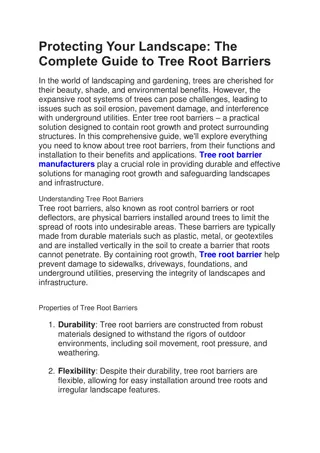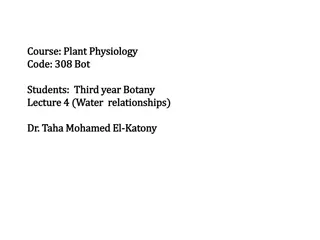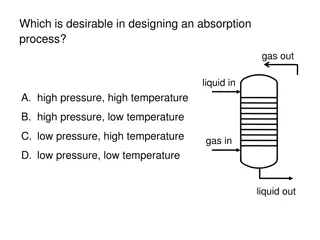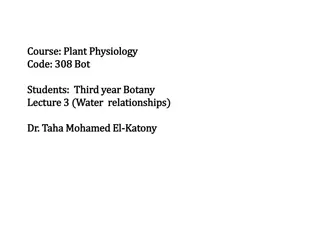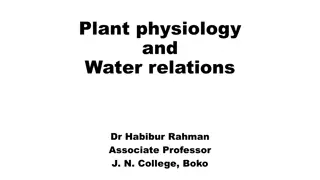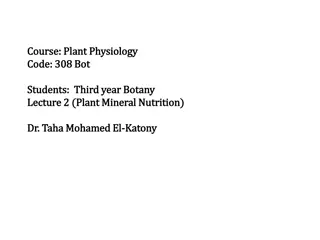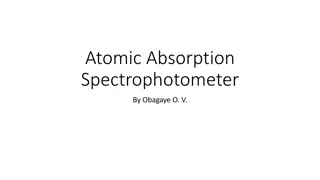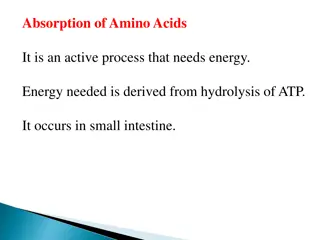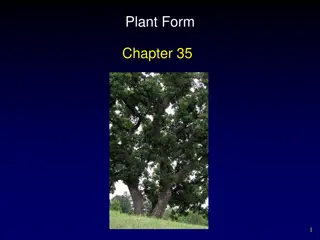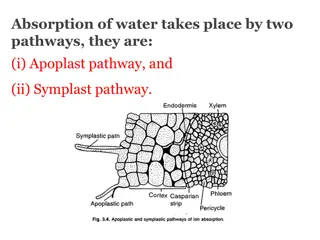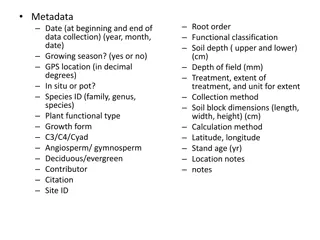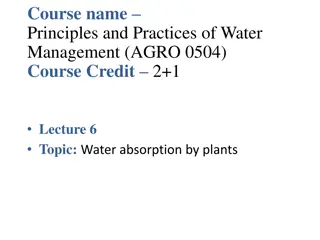Understanding Water Absorption in Plant Root Systems
Absorption of water by plant roots is a crucial process involving osmosis and gradients. The root system structure plays a vital role in water absorption efficiency, with root hairs being key to this process. Factors such as soil penetration depth and root hair characteristics impact the extent of water absorption. Understanding these mechanisms is essential for comprehending plant physiology and growth.
Download Presentation

Please find below an Image/Link to download the presentation.
The content on the website is provided AS IS for your information and personal use only. It may not be sold, licensed, or shared on other websites without obtaining consent from the author. Download presentation by click this link. If you encounter any issues during the download, it is possible that the publisher has removed the file from their server.
E N D
Presentation Transcript
Course: Plant Physiology Course: Plant Physiology Code: Code: 308 308 Bot Bot Students: Third year Botany Students: Third year Botany Lecture Lecture 2 2 (Water relationships) (Water relationships) Dr. Dr. Taha Taha Mohamed El Mohamed El- -Katony Katony
Absorption of water Absorption of water Water Water absorption takes place by the root system absorption takes place by the root system, particularly the root hair zone through osmosis. the root hair zone through osmosis. , particularly Water diffuses into the root hair and into other epidermal Water diffuses into the root hair and into other epidermal cells as a result of cells as a result of w w gradient. gradient. w w of the root cell sap is more of the root cell sap is more - -ve solution. solution. ve than than w w of the soil of the soil The cell The cell w w can be made more can be made more - -ve will increase by: will increase by: ve and hence water absorption and hence water absorption * increase in solute concentration of the cell (more * increase in solute concentration of the cell (more - -ve ve s s) ) * or decrease in its turgor pressure ( * or decrease in its turgor pressure ( p p) ). .
The root system The root system varies soil penetration and hence soil penetration and hence in water absorbing varies a great deal in a great deal in appearance in water absorbing capacity appearance and and extent extent of capacity. . of Root system of some plants penetrates Root system of some plants penetrates deep deep into the soil into the soil. . Other plants form a Other plants form a dense that that cover a large area of soil. cover a large area of soil. dense shallow shallow network of branch roots network of branch roots Root hairs are very Root hairs are very delicate period period of time (less than two days). of time (less than two days). delicate structures and last for a structures and last for a short short Rarely, r Rarely, root hairs oot hairs may persist These root hairs become lignified and suberized with age, These root hairs become lignified and suberized with age, which limit their ability to absorb water. which limit their ability to absorb water. may persist in some species. in some species.
Most Most of of the Why Why? ? the plant's plant's root root system system does does not not absorb absorb water water efficiently efficiently. . The The root naked naked zone root hair hair zone zone. . zone lies lies between between the the root root tip tip zone zone and and the the older older The The root involved involved in in absorption root tips tips represent represent the absorption. . the growing growing area area of of the the root root and and is is not not In In the the older older tissues secondary secondary thickening highly highly suberized suberized cells tissues of of the thickening takes cells develops the root, root, several takes place develops. . several mm place and mm back and a a periderm periderm layer back from from the the tip, layer of of tip, This This embed embed the the permeability permeability of of the the root root to to water water. .
Although Although efficient root root hair hair zone, of of the the root efficient water zone, water root. . water absorption absorption takes water may may also also be takes place be taken taken up place at at the up by by suberized suberized areas the unsuberized unsuberized areas Only Only a a very unsuberized unsuberized, , making up up water water. . very small small percentage percentage of of the making it it necessary the root root system necessary for for suberized system of of certain suberized tissues certain trees tissues to to take trees is is take The The suberized suberized roots roots of of some some trees trees can can absorb absorb a a dye dye solution solution. . This can be done through three ports of entry: This can be done through three ports of entry: *lenticels, *lenticels, *breaks around branch roots and *breaks around branch roots and *wounds. *wounds.
Path of water movement through root Path of water movement through root Water taken up into the root hairs moves through the cortex Water taken up into the root hairs moves through the cortex to to the endodermis, the the endodermis, the pericycle pericycle and finally into the xylem. xylem. and finally into the This can be done easily along the walls of the cortical cells. This can be done easily along the walls of the cortical cells. But the movement along the endodermal cell walls is But the movement along the endodermal cell walls is impeded impeded by the presence of the by the presence of the casparian casparian strip. strip. Water is diverted into the endodermal cell and follows a Water is diverted into the endodermal cell and follows a w w gradient into the gradient into the pericycle pericycle and into the xylem, which connects directly with the xylem of the stem. connects directly with the xylem of the stem. and into the xylem, which Water thus moves out of the root and into the stem. Water thus moves out of the root and into the stem.
Path of water movement in the leaf Path of water movement in the leaf The xylem of stem is divided and subdivided into a complex The xylem of stem is divided and subdivided into a complex network of vessels, which finally ends in the fine veins network of vessels, which finally ends in the fine veins of the leaf. of the leaf. Dicot Dicot. and monocot. leaves differ in mesophyll structure. . and monocot. leaves differ in mesophyll structure. Water moves from the Water moves from the tracheids mesophyll cells, where a small portion is used by the cells mesophyll cells, where a small portion is used by the cells and a large amount evaporates from the surface of cells and a large amount evaporates from the surface of cells into intercellular spaces. into intercellular spaces. tracheids of leaf veins into the of leaf veins into the Water vapor escapes from the Water vapor escapes from the substomatal the stomata into the atmosphere as a result of a very the stomata into the atmosphere as a result of a very steep water vapor gradient. steep water vapor gradient. substomatal chamber through chamber through
In In a a rapidly rapidly transpiring in in a a state state of of negative transpiring plant, negative pressure plant, the pressure or the xylem xylem vessels or tension tension. . vessels and and tracheids tracheids are are The The rate but but sometimes sometimes transpiration rate of of transpiration transpiration is is often transpiration can often similar similar to to the can exceed exceed absorption the rate rate of of absorption, absorption, absorption. . The The tension tension in in the the the root, root, and leaf is is transmitted transmitted to to the and water literally pulled the leaf water is is literally the stem stem and into the the root root from and then then to to from the the soil pulled into soil. . The The w w of of the to to increasing increasing negative the cell cell sap negative pressure sap becomes becomes more pressure (tension) more negative negative as (tension): : w w = = s s +( as it it is is subjected subjected +(- - p p) ). . The The more more negative negative w w leads leads to to increased increased water water uptake uptake. .
Water uptake, thus, occurs as a result of activity Water uptake, thus, occurs as a result of activity (transpiration) in the shoot. (transpiration) in the shoot. The root merely acts as an adsorbing and absorbing The root merely acts as an adsorbing and absorbing surface. surface. This phenomenon is clearly supported by the fact that the This phenomenon is clearly supported by the fact that the shoot can absorb water through dead roots and shoot can absorb water through dead roots and may, in fact, take it up at a faster rate. may, in fact, take it up at a faster rate. The resistance to water uptake by living roots may be The resistance to water uptake by living roots may be due to the living cells of the root. due to the living cells of the root.
Absorption of water by aerial parts of the plant Absorption of water by aerial parts of the plant Plant foliage can Plant foliage can absorb water (both liquid and vapor). absorb water (both liquid and vapor). The extent of foliar absorption depends on: The extent of foliar absorption depends on: a) a) the the w w of leaf cells and of leaf cells and b) b) permeability of the cutin layer. permeability of the cutin layer. T The cutin layer on the leaves of McIntosh apple is not continuous he cutin layer on the leaves of McIntosh apple is not continuous but occurs in lamellae parallel to epidermal cells but occurs in lamellae parallel to epidermal cells, , interspersed with parallel layers of interspersed with parallel layers of pectinaceous of good water absorbing capacity. of good water absorbing capacity. pectinaceous materials materials
This This pectinaceous pectinaceous material extends vertically to the vein material extends vertically to the vein extensions within the interior of the leaf forming a continuous extensions within the interior of the leaf forming a continuous path for water from the surface to the vascular tissue. path for water from the surface to the vascular tissue. Water absorbed by the leaves can travel in a negative direction Water absorbed by the leaves can travel in a negative direction through the plant and diffuse through the roots into the soil. through the plant and diffuse through the roots into the soil. This could occur along (down) This could occur along (down) w w gradient favoring movement in this direction. in this direction. gradient favoring movement
Apoplast Apoplast and and symplast symplast The The Apoplast Apoplast is the non intercellular spaces. intercellular spaces. is the non- -living continuum of cell walls and living continuum of cell walls and Since living cells are not included, translocation within this Since living cells are not included, translocation within this system is not due to osmosis but to capillary action system is not due to osmosis but to capillary action (water) and free diffusion (solutes). (water) and free diffusion (solutes). Symplast Symplast is the living continuum of is the living continuum of plasmodesmata cytoplasm. cytoplasm. plasmodesmata and and Movement of water and solutes into Movement of water and solutes into symplast osmosis (water), osmosis (water), free diffusion free diffusion or active uptake (solutes). symplast is due to is due to or active uptake (solutes).
Water moves from the soil into the root along a decreasing Water moves from the soil into the root along a decreasing w w gradient established by solute concentration. gradient established by solute concentration. Why the salt content of the interior cells of the root (the stele) Why the salt content of the interior cells of the root (the stele) is higher than that in the exterior cells. is higher than that in the exterior cells. Absorption and accumulation of salt by root cells requires Absorption and accumulation of salt by root cells requires metabolic energy. metabolic energy. Crafts and Crafts and Broyer energy gradient and an increasing CO energy gradient and an increasing CO2 2 gradient from the cortex to the stele. cortex to the stele. Broyer suggests that there is a decreasing O suggests that there is a decreasing O2 2 and and gradient from the Metabolic activity is thus at a minimum Metabolic activity is thus at a minimum in the interior cells adjacent to xylem ducts. adjacent to xylem ducts. in the interior cells
Thus the stele cells in contrast to the cortex cells favor the Thus the stele cells in contrast to the cortex cells favor the loss of loss of solutes. solutes. Because diffusion back through the impervious Because diffusion back through the impervious Casparian strip is not allowed, there will be a unidirectional loss of strip is not allowed, there will be a unidirectional loss of salt into the salt into the lumina lumina of the xylem vessels. of the xylem vessels. Casparian Water will follow this unidirectional path and diffuses from Water will follow this unidirectional path and diffuses from the less negative the less negative w w of the soil solution to the more of the soil solution to the more negative negative w w of the interior of the root. of the interior of the root.




